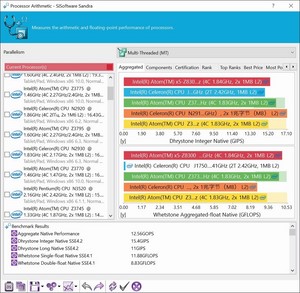Intel Compute Stick Cherry Trail Review: Pocket-Sized Windows 10 PC
Intel Compute Stick Performance
Even though this latest Compute Stick is packing an upgraded processor, faster memory, networking, and storage versus its predecessor, it still isn’t meant for high-performance computing applications. It’s designed for basic computing needs and is outfitted with the kind of hardware you’d normally find in tablet-type form factors, sans the screen of course. As such, we’re not going to run an extensive array of benchmarks, but rather test the Compute Stick in a few of the scenarios it was meant for. With that said, we do have a few numbers to share just to give you some reference points.
In the four SiSoft SANDRA modules we ran (Processor Arithmetic, Multi-Media, Memory, File System), the Intel Compute Stick performed as expected. The Atom processor at the heart of the device performed about on par with a Celeron J1750. In the Multi-Media benchmark, performance was in the range of a Celeron N2910 and some older Atom-class processors. Memory bandwidth of the single-channel of DDR3 RAM in the Compute Stick peaked at just under 6GB/s. And the internal storage—which incidentally uses SanDisk flash memory, and not Intel—put up some decent numbers, averaging around 133MB/s.
 We also ran SunSpider to get an idea as to how the Compute Stick performs while browsing / executing JavaScript, using the Microsoft Edge browser, and got a score just over 466ms, which puts the Compute Stick ahead of an NVIDIA Tegra 3 and previous-gen Compute Stick, but behind some of the latest smartphones.
We also ran SunSpider to get an idea as to how the Compute Stick performs while browsing / executing JavaScript, using the Microsoft Edge browser, and got a score just over 466ms, which puts the Compute Stick ahead of an NVIDIA Tegra 3 and previous-gen Compute Stick, but behind some of the latest smartphones.

The GeekBench benchmark doesn't paint a very rosy picture for the Compute Stick. Here, the Atom CPU inside the device finishes dead last in comparison to an array of ARM and Intel based smartphones and tablets.

We also ran some quick numbers in a simple audio-encoding tool to show you were the Compute Stick's Atom x5-Z8300 falls in comparison to some other x86-based low-power processors.
In the types of scenarios the Compute Stick is designed for, it works very well. We also played back a myriad of videos—streaming from the web, from a local network, and local to the device, and accessed other systems remotely. We even streamed games using Steam in-home streaming capabilities.
Streaming SD and HD videos from YouTube went off without a hitch. The image above is from an HD version of the Captain America: Civil War trailer, set to 1080p, but scaled to full screen on a 4K display, and it played back lag-free using only the built-in WiFi to connect to the web. Regardless of the resolution, this clip played back smoothly, however, and CPU utilization remained relatively low.
This shot is from the Suicide Squad trailer, streaming from YouTube at 4K (2160P). As long as we let this one buffer a bit, it played smoothly for the most part too, but with relatively high CPU utilization. If we performed any other tasks on the system, CPU utilization would spike to 100% and frames would be dropped.
In addition to streaming from the web, we also played an assortment of 1080P MP4 files, grabbed from a NAS or copied locally. All of them played back without a hitch as well.
In the four SiSoft SANDRA modules we ran (Processor Arithmetic, Multi-Media, Memory, File System), the Intel Compute Stick performed as expected. The Atom processor at the heart of the device performed about on par with a Celeron J1750. In the Multi-Media benchmark, performance was in the range of a Celeron N2910 and some older Atom-class processors. Memory bandwidth of the single-channel of DDR3 RAM in the Compute Stick peaked at just under 6GB/s. And the internal storage—which incidentally uses SanDisk flash memory, and not Intel—put up some decent numbers, averaging around 133MB/s.


The GeekBench benchmark doesn't paint a very rosy picture for the Compute Stick. Here, the Atom CPU inside the device finishes dead last in comparison to an array of ARM and Intel based smartphones and tablets.

We also ran some quick numbers in a simple audio-encoding tool to show you were the Compute Stick's Atom x5-Z8300 falls in comparison to some other x86-based low-power processors.
In the types of scenarios the Compute Stick is designed for, it works very well. We also played back a myriad of videos—streaming from the web, from a local network, and local to the device, and accessed other systems remotely. We even streamed games using Steam in-home streaming capabilities.
Streaming SD and HD videos from YouTube went off without a hitch. The image above is from an HD version of the Captain America: Civil War trailer, set to 1080p, but scaled to full screen on a 4K display, and it played back lag-free using only the built-in WiFi to connect to the web. Regardless of the resolution, this clip played back smoothly, however, and CPU utilization remained relatively low.
This shot is from the Suicide Squad trailer, streaming from YouTube at 4K (2160P). As long as we let this one buffer a bit, it played smoothly for the most part too, but with relatively high CPU utilization. If we performed any other tasks on the system, CPU utilization would spike to 100% and frames would be dropped.
In addition to streaming from the web, we also played an assortment of 1080P MP4 files, grabbed from a NAS or copied locally. All of them played back without a hitch as well.












